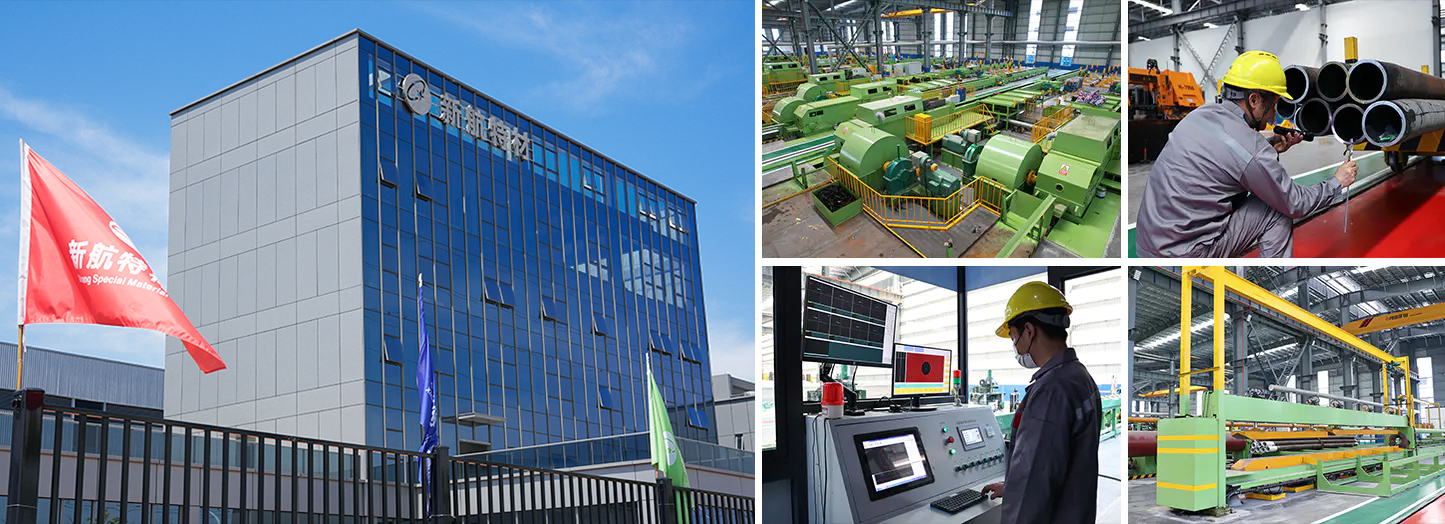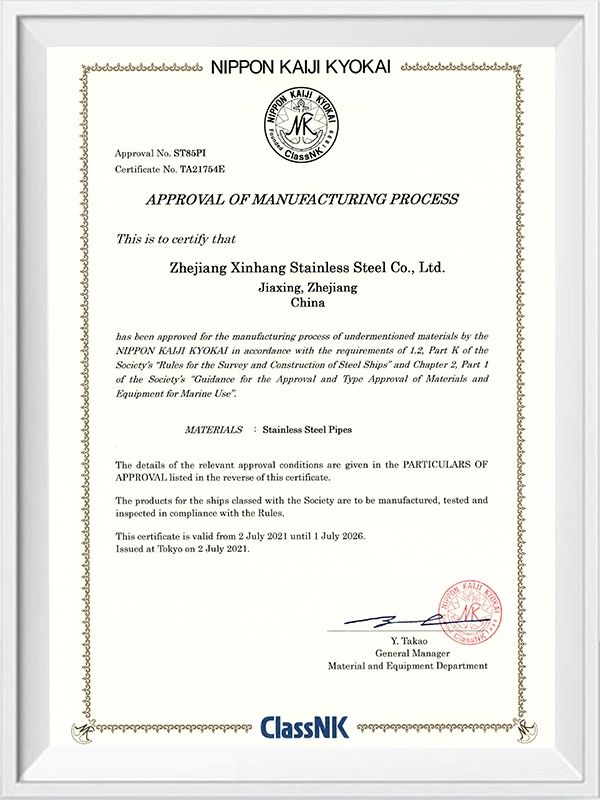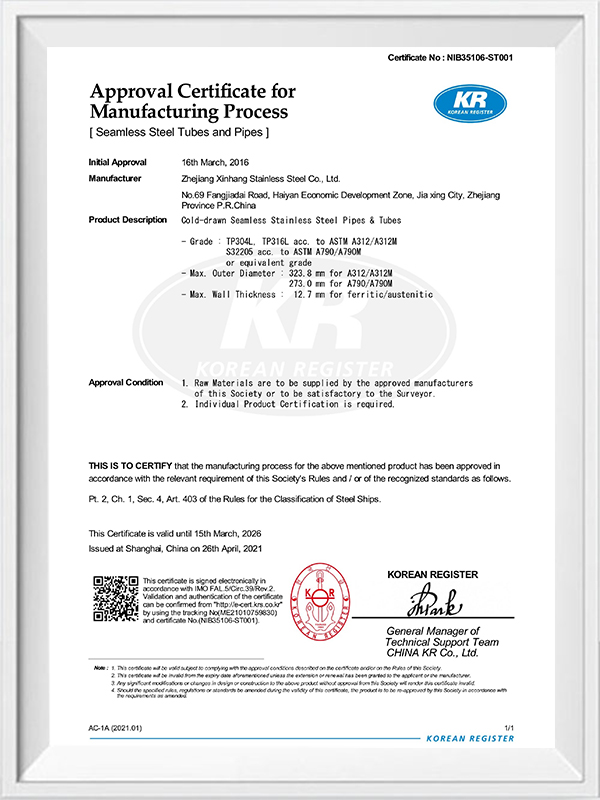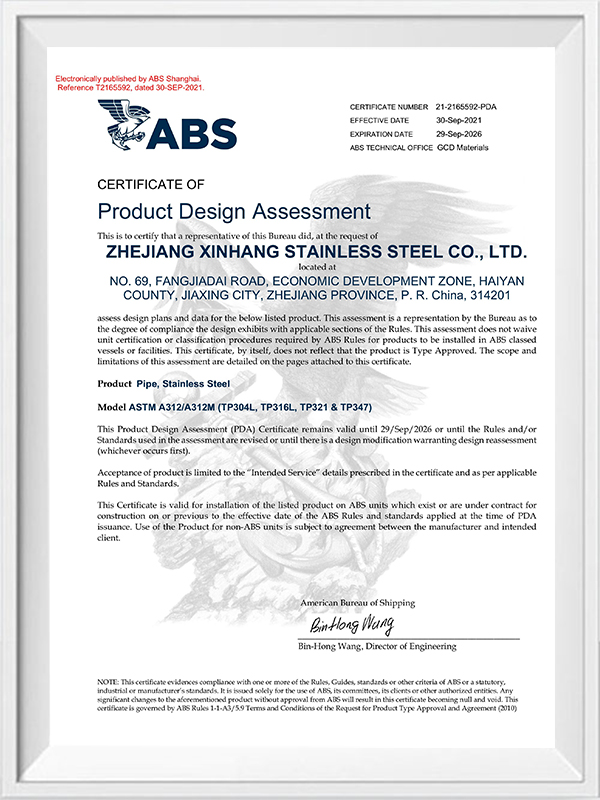

Xinhang Special Material Co., Ltd. Hangzhou Branch is China stainless steel tubes for heat exchangers/condensers Manufacturers and stainless steel tubes for heat exchangers/condensers Factory, founded in 2007 and moved to Longyou Economic Development Zone, Zhejiang Province, in 2022. It covers an area of 130,000 square meters, more than 30 production lines, 300 workers, 20 R&D people, 30 inspection people and an annual output of 50,000 tons.
It has passed ISO9001:2008 quality management system, PED 97/23/EC EU Pressure Equipment Directive certification, China Special Equipment Manufacturing License (Pressure Tube) TS certification, ASME certification, provincial enterprise standardization management system, ISO14000:2004 environment management system, cleaner production (green enterprise), and a series of certifications, as well as China Classification Society (CCS), American Bureau of Shipping (ABS), British Register of Shipping (LR), Deutsche Veritas (GL), Bureau Veritas Society (BV), Det Norske Veritas (DNV), and Korean Register of Shipping (KR) factory certification.
The main products include stainless steel pipes, pipe fittings, flanges, valves, etc., which are widely used in petroleum, chemical industry, nuclear industry, smelting, shipbuilding, pharmaceuticals, food, water conservancy, electric power, new energy, mechanical equipment, and other fields. The company adheres to the corporate tenet of "quality for survival, reputation for development" and wholeheartedly serves every customer to create a win-win situation.




Introduction to Alloy Steel Alloy steel is a type of steel that is made by combining carbon steel with various alloying ...
View MoreMass Density of Mild Steel: Basics and Practical Importance The mass density of mild steel is a fundamental property tha...
View MoreUnderstanding Stress Proof Steel Stress proof steel is a type of alloyed steel engineered to resist deformation under lo...
View MoreIntroduction to Low Alloy Steel Material Low alloy steel material is a type of steel that contains a small percentage of...
View MoreWhat factors influence the heat transfer efficiency of stainless steel tubes in heat exchangers?
Thermal Conductivity of Stainless Steel: The thermal conductivity of the stainless steel material used in the tubes directly affects how efficiently heat is transferred between the fluid flowing inside the tubes and the surrounding fluid or surface. Higher thermal conductivity typically leads to better heat transfer efficiency.
Surface Area: The surface area of the stainless steel tubes for heat exchangers in contact with the heat transfer fluids impacts the overall heat transfer rate. Increasing the surface area, for example, by using tubes with extended surfaces (such as fins or turbulators), enhances heat transfer efficiency.
Fluid Flow Rate: The velocity of the fluid flowing inside the tubes influences heat transfer efficiency. Higher flow rates can promote turbulence and improve convective heat transfer, enhancing efficiency. However, excessively high flow rates may increase pressure drop and energy consumption.
Temperature Difference: The temperature gradient between the fluid inside the tubes and the external environment or the fluid in the other side of the heat exchanger affects the rate of heat transfer. A larger temperature difference typically results in higher heat transfer rates, up to a certain point.
Tube Geometry and Design: Factors such as tube diameter, length, and configuration (e.g., straight tubes, U-tubes, helical coils) impact heat transfer efficiency. Optimal tube geometry is often determined by balancing factors like pressure drop, flow distribution, and fouling resistance.
Fluid Properties: The thermal properties of the fluids involved, such as specific heat capacity, viscosity, and density, affect heat transfer efficiency. Additionally, the presence of phase changes (e.g., condensation or boiling) can significantly alter heat transfer rates.
Surface Conditions: The cleanliness and smoothness of the tube surfaces influence heat transfer efficiency. Fouling, scale deposition, or corrosion can reduce heat transfer rates by insulating the tubes and impeding fluid flow.
Operating Conditions: Parameters such as operating pressure, temperature, and flow regime (e.g., laminar or turbulent flow) affect heat transfer efficiency. Operating conditions outside the design parameters can lead to decreased efficiency or equipment failure.
Material Compatibility: Compatibility between the stainless steel material of the tubes and the fluids being processed is essential to maintain heat transfer efficiency over time. Corrosion or chemical reactions can degrade tube surfaces, reducing heat transfer rates.
Insulation: The presence or absence of insulation around the heat exchanger system can impact overall heat transfer efficiency by minimizing heat loss to the surroundings or reducing temperature gradients within the system.
What considerations should be made during the installation of stainless steel condenser tubes?
Handling and Storage:Stainless steel tubes should be handled with care to avoid damage to their surfaces, which can lead to corrosion.
Tubes should be stored in a clean, dry area to prevent contamination and corrosion during storage.
Surface Preparation:Before installation, the tube ends should be properly cleaned and deburred to ensure a smooth surface and proper fit with fittings or connectors.
Any protective coatings or films applied during storage should be removed prior to installation.
Compatibility with System Components:Ensure that all fittings, connectors, and other system components are compatible with stainless steel material to prevent galvanic corrosion.
Use appropriate gaskets and seals that are compatible with stainless steel to prevent leaks and ensure a tight seal.
Proper Support and Alignment:stainless steel tubes for condensers should be properly supported and aligned to prevent sagging, vibration, or stress on the tubes.
Use suitable hangers, brackets, or supports at regular intervals to maintain proper alignment and prevent excessive strain on the tubes.
Avoid Contamination:During installation, take precautions to prevent contamination of the stainless steel surface from dirt, debris, or other foreign materials.
Use clean tools and equipment, and avoid contact with materials that can cause contamination, such as carbon steel.
Avoid Damage During Installation:Take care to avoid damage to the stainless steel tubes during installation, such as scratches, dents, or deformation, which can compromise their integrity and lead to corrosion.
Use appropriate tools and techniques for cutting, bending, and fitting the tubes to minimize the risk of damage.
Proper Tightening of Connections:When connecting stainless steel tubes to fittings or connectors, ensure that connections are properly tightened according to manufacturer recommendations.
Over-tightening can cause damage to the tube or fittings, while under-tightening can lead to leaks.
Consideration for Thermal Expansion:Account for thermal expansion and contraction of stainless steel tubes during operation by allowing for proper clearance and flexibility in the installation.
Use expansion loops or flexible connectors where necessary to accommodate thermal movement without stressing the tubes or system components.
We'll never share your email address and you
can opt out at any time, we promise.